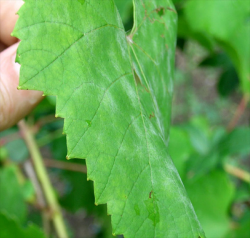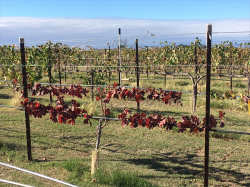March 16, 2019
March 16, 2019
Question:
My husband and I are planting a few Marquette grape vines this year in Santa Fe. I would like to plant a tree approximately 8 feet from the vines. Could you recommend some trees that would be "a good idea" to plant close by? I read that planting a rose bush at the vines will help to indicate any diseases since the roses would get this first. Is this a good thing to do? Are rabbits a problem with grape vines? We have quite a few roaming freely. Should we protect the vines with a net around them?
- Susan R., Santa Fe
Answer:
For the tree portion of your query, what direction, relative to the grapes, will the tree be planted? Will the tree shade the grape vines? Even if the tree is planted on the north side of the grape-growing area, it may shade the grapes once the canopy gets larger, so selecting a small tree might be helpful. For a list of small trees to consider, visit the online version of this column at Desert Blooms.

Generally speaking, I encourage planting as many species together as possible and am not worried about competition between plants as long as enough water is applied for all to thrive. Competition between plants is only an issue if there is a limited resource. By “resource” we usually mean water, nutrients, and light. There are multiple benefits associated with increased species diversity in a given area, from pollinator populations to ground cover that shades root zones and helps mitigate soil temperatures.
I was interested to hear suggestions from NMSU Extension Viticulture Specialist, Dr. Gill Giese, regarding shade, roses in the vineyard, rabbit habits, and netting, so I invited him to weigh in:
“The Marquette grape is a complex hybrid grape developed and released by the University of Minnesota. It is a good choice for your location due to its cold hardiness. It is resistant to powdery and downy mildew. Although downy mildew does not typically occur in New Mexico, powdery mildew is a fungal disease that does affect vines across the state every year. (For more information, see NMSU Extension Guide H329: Grape Powdery Mildew. When temperatures are moderate, skies are overcast, and humidity increases slightly, this disease will pop up. It can infect leaves and fruit, and will degrade grape quality whether the fruit is destined for juice or wine. Because the disease only infects the leaf or fruit surface, it can be controlled with topically applied sulfur-based fungicides and/or some plant-safe oils that are acceptable to organic producers. UV light kills the causal organism, Erysiphe necator (syn. Uncinula necator), and thus the more open the plant canopy is and the more exposed the leaves and fruit are to direct sunlight and air flow, the better. Although grapes thrive in full sun, some shade for part of the day, especially in late afternoon in New Mexico, could be advantageous given the intensity of the sunlight here.

“There is much folklore surrounding the practice of planting roses at row ends for disease warning. But in many instances, grapes will contract powdery mildew before a nearby rose bush. So, from a disease 'warning system' point of view, the rose bush at the row end is not of much use.
“Another disease that occurs on grape, especially on the fruit near harvest, is Botrytis. Minimizing powdery mildew infections early will go a long way toward preventing/managing Botrytis. I would not anticipate it being much of a threat to Marquette due to its fairly open cluster architecture and the relatively tough skins of the individual berries. A final group of diseases I have observed in New Mexico vineyards are wood rotting diseases, but these do not typically show up until the vines reach five years old and beyond. Infected vines that are watered and moderately fertilized will continue to grow and produce. In other words, they can tolerate this particular insult quite well.
“Grapevines, especially young ones 1 to 5 years old, in an area where only a few vines are planted should be protected from rabbits and other animals that like to gnaw on bark. The rabbits can easily and completely girdle a young vine and kill it. If you use grow tubes, please be aware that while they can protect the vine from "varmints," they often create the ideal environment for weeds and—with a little rainfall or irrigation—powdery mildew, so check inside the tubes periodically. Netting or chicken wire might be preferable. Netting will be especially useful for protecting the entire vine canopy when your grapes are ripening and approaching maturity as birds typically find them before you do and can eat your entire crop in a short time.”
Dr. Giese’s viticulture program is growing by leaps and bounds. Follow the action on Twitter (@NMSUViticulture) and find a list of upcoming workshops, presentations, and very helpful videos on how to rejuvenate older grapevines at the NMSU Viticulture site. Also check out their new blog at Ampelos.
Marisa Y. Thompson, PhD, is the Extension Horticulture Specialist, in the Department of Extension Plant Sciences at the New Mexico State University Los Lunas Agricultural Science Center, email: desertblooms@nmsu.edu, office: 505-865-7340, ext. 113.
Links:
For more gardening information, visit the NMSU Extension Horticulture page at Desert Blooms and the NMSU Horticulture Publications page.
Send gardening questions to Southwest Yard and Garden - Attn: Dr. Marisa Thompson at desertblooms@nmsu.edu, or at the Desert Blooms Facebook page.
Please copy your County Extension Agent and indicate your county of residence when you submit your question!